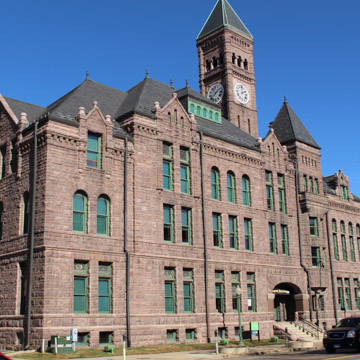You are here
Old Courthouse Museum
The former Minnehaha County Courthouse is one of the most substantial buildings in downtown Sioux Falls. The three-story building has a tower that extends high over the entrance facing Main Street, with clocks on each of the tower’s four elevations. Designed by local architect Wallace Dow (1844–1911), the courthouse is constructed of dark pink Sioux quartzite from the Sioux Falls Granite Company—a material used in many of Sioux City’s public, educational, and ecclesiastical buildings. The picturesque massing, rusticated stone, round-arched upper-level windows, and deeply recessed entrances are hallmarks of the Richardsonian Romanesque design. A two-story jail, which matches the courthouse building in style and materials, sits adjacent the courthouse on the west and was built first, in 1880. The county rented offices elsewhere in the city until the courthouse was completed in 1893.
The interior of the building is largely intact. Finishes include slate stairs, granite columns, stained glass windows, and tiled fireplaces. There are also sixteen large murals painted by Norwegian immigrant Ole Running between 1915 and 1917; these depict early Dakota life, natural landscapes, and images of Running’s life in Norway.
The building served the county until 1962, when a larger structure was built adjacent to the west. The original courthouse was slated for demolition but concerned citizens campaigned to save it. In 1974, the building reopened as a museum with three floors of exhibit space dedicated to regional history. The circuit courtroom and law library on the second floor have been restored. It is now part of the Siouxland Heritage Museums, which also includes the Pettigrew Home and Museum and the Irene Hall Museum Resource Center.
References
Writing Credits
If SAH Archipedia has been useful to you, please consider supporting it.
SAH Archipedia tells the story of the United States through its buildings, landscapes, and cities. This freely available resource empowers the public with authoritative knowledge that deepens their understanding and appreciation of the built environment. But the Society of Architectural Historians, which created SAH Archipedia with University of Virginia Press, needs your support to maintain the high-caliber research, writing, photography, cartography, editing, design, and programming that make SAH Archipedia a trusted online resource available to all who value the history of place, heritage tourism, and learning.























